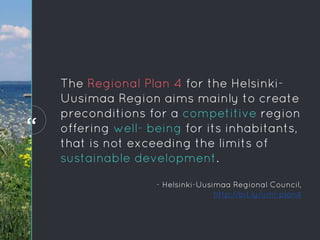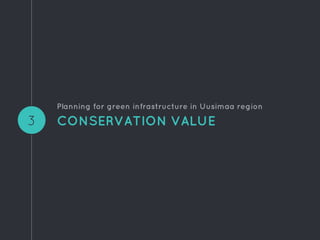Tools for spatial conservation prioritization
- 1. Tools for Spatial Conservation Planning Flora- och Faunavård 2016
- 2. You are free to: Icons from Creative Commons (CC-BY 3.0) and Font Awesome (SIL Open Font License (OFL)) Provided that: Copy, share, adapt, or re-mix Photograph, film, or broadcast Blog, live-blog, or post video of; You attribute the work to its author and respect the Rights and licenses associated with its components
- 3. Hej! I’M JOONA LEHTOMÄKI I come from Vrije Universiteit Amsterdam where I work as a post-doc. @jlehtoma jlehtoma
- 4. BACKGROUND Introduction to spatial conservation prioritization 1
- 5. SPATIAL CONSERVATION PRIORITIZATION Identify spatial allocation of conservation resources (actions) ◦ Protection ◦ Management ◦ Restoration ◦ Offsetting … and various other forms of land use.
- 6. Species often used as biodiversity units in conservation Communities, processes or services can be considered as well Use of surrogates inevitable: perfect information of biodiversity not feasible BIODIVERSITY FEATURES
- 7. Area: quantity of available habitat Quality: density of resources (dead- wood etc.) Aggregation: spatial arrangement of habitat 3 FUNDAMENTAL AXES OF SPATIAL ECOLOGY
- 8. HOW DO THE AXES AFFECT POPULATION SIZES? Populationsize AREA QUALITY AGGREGATION Hodgson et al. (2009)
- 9. COMPONENTS OF WELL-INFORMED CONSERVATION DECISION MAKING Biodiversity (features) and their distributions now Threats about persistence of features Human conservation preferences and objectives Costs (economics of conservation) Socio-political constraints
- 10. A GENERAL FRAMEWORK FOR CONSERVATION RESOURCE ALLOCATION Objective Models of distribution From distribution to conservation value Alternative conservation actions Constraints Solution Implementation
- 11. Objectives drive outcome → important to be clear and explicit about them ◦ Single objective ◦ Multi-objective (conservation is inherently multi-objective) “Population size > x” “Fraction of distribution protected > x” “Ecosystem services produced > x” A general framework THE OBJECTIVE
- 12. THE OBJECTIVE A general framework Halting biodiversity loss Climate change mitigation High-level objectives Low-level objectives Decreasing the effects of land-use Developing green infrastructure HabitatsSpecies Services Processes Area Quality Aggregatio n
- 13. Models of biodiversity distribution ◦ Observed static distribution ◦ Predicted static distribution ◦ Stationary time-varying distribution ◦ Non-stationary time-varying distribution Adding realism usually increases complexity and requires more data and resolution MODELS OF DISTRIBUTION A general framework
- 14. FROM DISTRIBUTION TO CONSERVATION VALUE A general framework Which features are included? What structural components does the model include (e.g. connectivity and threats) How are features and structural components weighted in relation to each other? How is aggregate conservation value summarized across many features, space and time?
- 15. Quantitative: ○Mathematical ○Statistical MODEL OF CONSERVATION VALUE Qualitative: ○Verbal ○Mental Main factors: features, space, time
- 16. Protection (reduction of loss) Maintenance (management to maintain favourable conditions) Restoration (to return closer to past more favourable conditions or succession trajectory) Resource allocation between several alternative actions is not straightforward A general framework ALTERNATIVE CONSERVATION ACTIONS
- 17. CONSTRAINTS A general framework CONSTRAINTS ON Resources (budget, area etc.) Actions (what is feasible) Knowledge (human resources)
- 18. ◦ Direct cost ◦ Opportunity cost (loss due to lost opportunity) ◦ Cost efficiency (return on investment) = (sum of benefits) / (sum of costs) CONSERVATION COSTS
- 19. Quantitative analysis to generate solutions Several software packages available, with slightly different strategies ◦ Zonation ◦ Marxan (family) ◦ C-Plan ◦ ConsNet SOLUTION A general framework
- 20. Relevant constraints should be accounted for when constructing a solution Often difficult (but not impossible) to include in a quantitative analysis ◦ Local socio-political considerations ◦ Stakeholder values and preferences ◦ Anything that is not quantitative IMPLEMENTATION A general framework
- 21. IMPLEMENTATION A general framework Knight et al. (2009)
- 22. Conservation planners toolbox Objective Models of distribution From distribution to conservation value Alternative conservation actions Constraints Solution Implementation GIS Participatory GIS Species distribution models Landscape simulators Visualization tools SCP tools
- 26. HISTORY 2006 2008 2012 2015
- 27. ZONATION CONSERVATION PRIORITIZATION FRAMEWORK AND SOFTWARE Produces a hierarchical zoning of the landscape aiming at biodiversity persistence in a balanced way.
- 28. What is it not? Zonation
- 29. Statistical species distribution modelling (SDM) tool Tool designed primarily for connectivity analysis and corridors General purpose geographic information system (GIS)
- 30. What does it do? Zonation
- 31. TYPICAL QUESTIONS ADDRESSED Identification of ecologically least important areas for impact avoidance of development Evaluation of existing or proposed PAs Zonation Identification of ecologically most important areas for reserve network expansion
- 32. TYPICAL QUESTIONS ADDRESSED Spatial allocation of habitat maintenance and restoration Targeting financial incentives for conservation Planning for biodiversity offsets Zonation
- 33. Species often used as biodiversity units in conservation Communities, processes or services can be considered as well Use of surrogates inevitable: perfect information of biodiversity not feasible BIODIVERSITY FEATURES Recap
- 34. Feature specific weights and connectivity MAJOR FEATURES Can include uncertainty and costs Species and community level prioritization Zonation
- 35. MAJOR FEATURES Balancing alternative land uses Landscape condition and retention Prioritization across administrative regions Zonation
- 36. How does it work? Zonation
- 39. INPUT DATA: CATEGORIZATION Zonation Expert knowledge Modelled Observed, indirect Observed, direct
- 40. CONSTRAINTS Recap CONSTRAINTS ON Resources Actions Knowledge Costs (e.g. €/SEK) Condition (e.g. degradation) Uncertainty (e.g. model uncert.)
- 41. INPUT DATA Zonation Objectives Models of distribution Selected features Weights Connectivity Conservation value € Constraints Alternative conservation actions Solution
- 42. Absolute value CELL REMOVAL Zonation algorithm 4 10 15 5 23 32 20 40 51 0.02 0.05 0.075 0.025 0.115 0.16 0.1 0.2 0.255 Normalized values 0.051 0.0765 0.0255 0.1174 0.1632 0.102 0.2041 0.2602 0.0523 0.0785 0.1204 0.1675 0.1047 0.2094 0.2670 0.0828 0.1270 0.1767 0.1104 0.2209 0.2817 0.1385 0.1927 0.1204 0.2409 0.3072 0.1575 0.2191 0.2739 0.3493 0.2601 0.3252 0.41460.4395 0.56041.0 Ranking = reverse cell removal order
- 43. Zonation algorithm CELL REMOVAL MULTI SPECIES CELL REMOVAL
- 44. TERMINOLOGY Complementarity = a measure of the extent that different sites in a reserve network complement each other to achieve conservation goals.
- 45. Zonation algorithm CELL REMOVAL Core-area Zonation (CAZ) ◦ Cell value is the maximum biological value within the cell, across all features/species ◦ Somewhat emphasizes rarity Additive benefit function (ABF) ◦ Cell value is the sum of value across species within the cell ◦ Somewhat emphasizes richness → Different rules implement different conceptions of conservation value
- 46. Zonation basic output 1 RANK PRIORITY MAP Rank priority Map is not a final product Kuusterä et al. (2015)
- 47. Zonation basic output 1 RANK PRIORITY MAP Rank priority With connectivity Kuusterä et al. (2015) Map is not a final product
- 48. Zonation basic output 1 RANK PRIORITY MAP Rank priority With connectivity and zoning areas Kuusterä et al. (2015) Map is not a final product
- 49. Zonation basic output 2 PERFORMANCE CURVES
- 50. Rank priority Zonation basic output 2 PERFORMANCE CURVES Kuusterä et al. (2015) Map is not a final product
- 51. Zonation BALANCING ACT Moilanen et al. (2011)
- 53. GIS OVERLAY (SCORING) vs COMPLEMENTARITY Performance WHAT’S THE DIFFERENCE?
- 54. GIS OVERLAY (SCORING) vs COMPLEMENTARITY Performance Kullberg et al. (2015)
- 55. GIS OVERLAY (SCORING) vs COMPLEMENTARITY Performance Kullberg et al. (2015)
- 56. Kuusterä, J., Aalto, S., Moilanen, A., Toivonen, T., & Lehtomäki, J. (2015). Uudenmaan viherrakenteen analysointi Zonation- menetelmällä. Helsinki, Uudenmaanliitto. http://bit.ly/uml-zonation Case study 1: Planning for green infrastructure in Uusimaa region, Finland
- 57. OBJECTIVES1 Planning for green infrastructure in Uusimaa region
- 58. “ The Regional Plan 4 for the Helsinki- Uusimaa Region aims mainly to create preconditions for a competitive region offering well- being for its inhabitants, that is not exceeding the limits of sustainable development. “ - Helsinki-Uusimaa Regional Council, http://bit.ly/uml-plan4
- 59. Planning for green infrastructure in Uusimaa region OBJECTIVES Main themes: 1. Business and innovation 2. Logistics 3. Wind energy 4. Green infrastructure 5. Cultural heritage Helsinki-Uusimaa Regional Council (2015)
- 60. Green infrastructure framing and scope ◦ Biodiversity ◦ Ecological networks ◦ Recreational networks ◦ Natural resources (narrow scope) ◦ Ecosystem services (narrow scope) → spatial prioritization of high nature values sites with relatively low human disturbance Planning for green infrastructure in Uusimaa region OBJECTIVES
- 61. MODELS OF DISTRIBUTION2 Planning for green infrastructure in Uusimaa region
- 62. 1 2 3 MODELS OF DISTRIBUTION Planning for green infrastructure in Uusimaa region Habitat data (e.g.) ◦ Valuable forests ◦ Geodiversity ◦ Peatlands and wetlands Species data (e.g.) ◦ Threatened species ◦ Birds ◦ Large carnivores and game species PAs and ecosystem services (e.g.) ◦ Protected areas and programmes ◦ ESS provision potential Land-use (e.g.) ◦ Built areas ◦ Groundwater areas ◦ Land-use change scenarios 4
- 63. Kuusterä et al. (2015)
- 64. CONSERVATION VALUE3 Planning for green infrastructure in Uusimaa region
- 65. Additive benefit function (ABF) ◦ Somewhat emphasizes richness More weight to habitats, threatened species Connectivity: Matrix connectivity Division to administrative (sub) units Planning for green infrastructure in Uusimaa region CONSERVATION VALUE
- 66. ALTERNATIVE CONSERVATION ACTIONS 4 Planning for green infrastructure in Uusimaa region
- 67. No direct actions, but plan designations can later be used for targeting land-use development ALTERNATIVE CONSERVATION ACTIONS Planning for green infrastructure in Uusimaa region Kuusterä et al. (2015)
- 68. CONSTRAINTS5 Planning for green infrastructure in Uusimaa region
- 69. CONSTRAINTS Planning for green infrastructure in Uusimaa region 1. Lowered ecological condition through land-use 2. Lowered environmental condition through anthropogenic noise
- 70. SOLUTIONS6 Planning for green infrastructure in Uusimaa region
- 71. SOLUTION Planning for green infrastructure in Uusimaa region Local quality of the biodiversity features Kuusterä et al. (2015)
- 72. SOLUTION Planning for green infrastructure in Uusimaa region Including land-use and connectivity Kuusterä et al. (2015)
- 73. SOLUTION Planning for green infrastructure in Uusimaa region Coverageoffeature distributions(%) Fraction of area (%) Protected areas in the regional plan Poorest performing feature Average over all features Recreational areas in the regional plan Best 10% inZonation analysis Kuusterä et al. (2015)
- 74. IMPLEMENTATION7 Planning for green infrastructure in Uusimaa region
- 75. No immediate actions, results will be used in later stages IMPLEMENTATION Evaluation of the proposed benthic protection areas of New Zealand The future ◦ Other regional councils interested as well ◦ More emphasis on ecosystem services
- 76. Kuusterä et al. (2015)
- 77. REFERENCES Hodgson, J. A., Thomas, C. D., Wintle, B. A., & Moilanen, A. (2009). Climate change, connectivity and conservation decision making: back to basics. Journal of Applied Ecology, 46(5), 964–969. http://doi.org/10.1111/j.1365-2664.2009.01695.x Knight, A. T., Cowling, R. M., Possingham, H. P. & Wilson, K. A. (2009). From Theory to Practice: Designing and Situating Spatial Prioritization Approaches to Better Implement Conservation Action. In A. Moilanen, K. A. Wilson, & H. P. Possingham (Eds.), Spatial Conservation Prioritization: Quantitative Methods & Computational Tools (p. 304). Oxford: Oxford University Press. Kuusterä, J., Aalto, S., Moilanen, A., Toivonen, T., & Lehtomäki, J. (2015). Uudenmaan viherrakenteen analysointi Zonation-menetelmällä. Helsinki. URL: http://www.uudenmaanliitto.fi/files/15491/Uudenmaan_viherrakenteen_analysointi _Zonation-menetelmalla_E145-2015.pdf
- 78. CREDITS Special thanks to all the people who made and released these awesome resources for free: ◦ Simple line icons by Mirko Monti ◦ Presentation template by SlidesCarnival Special thanks to Atte Moilanen













































































